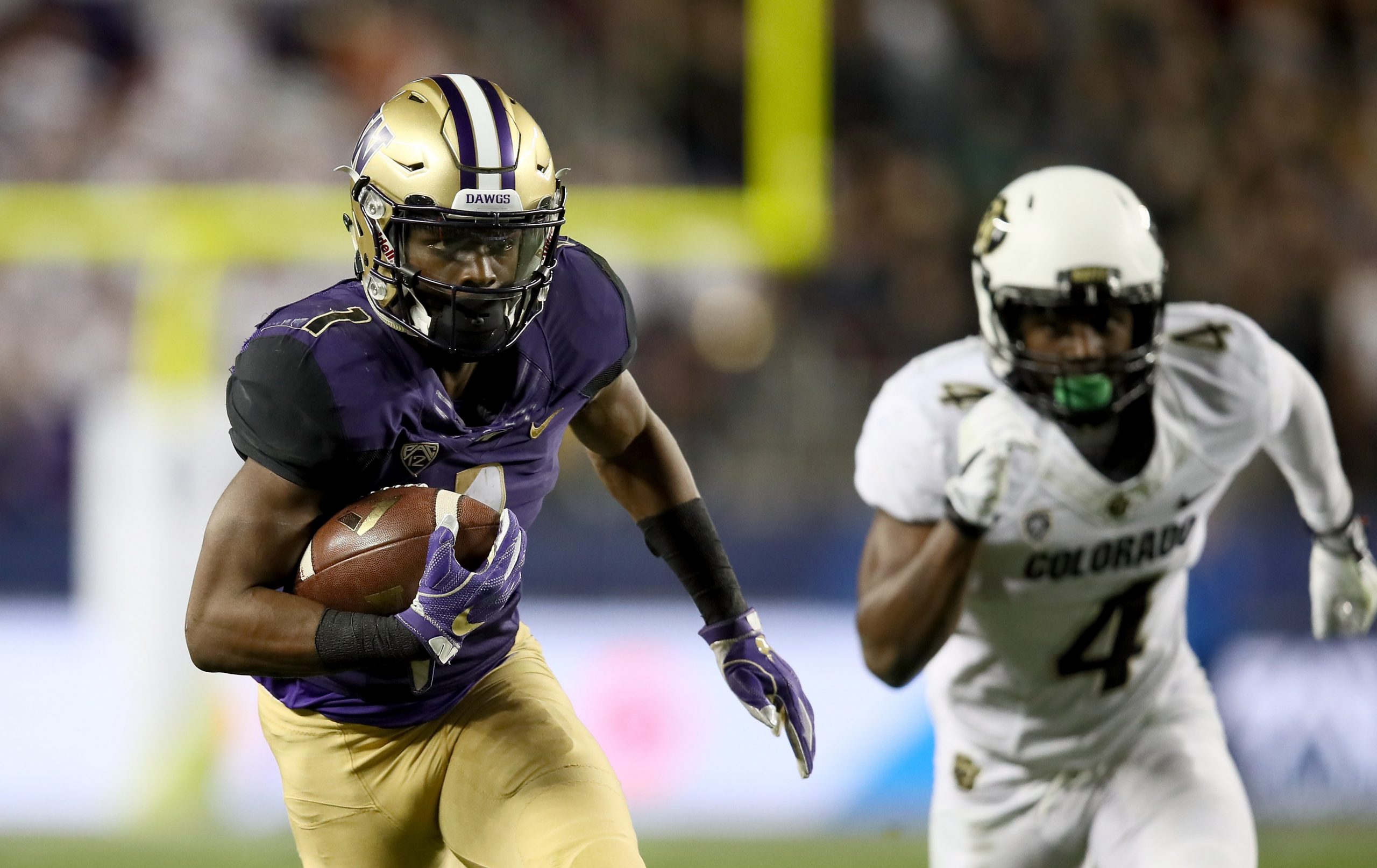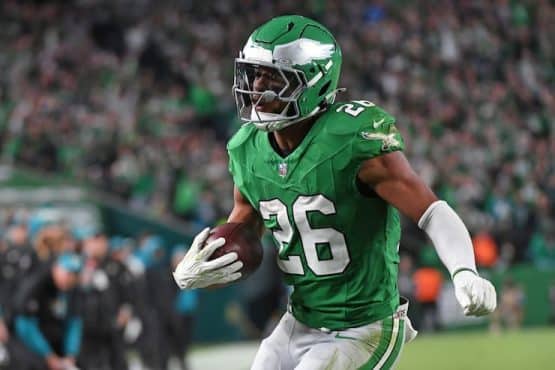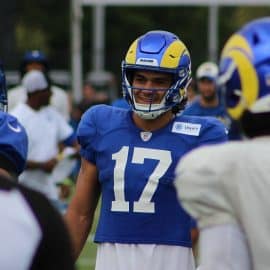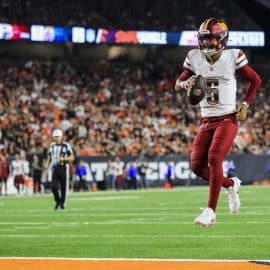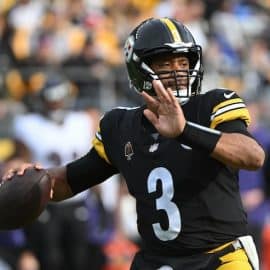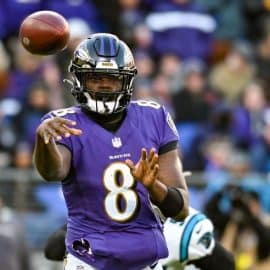Building an NFL team begins in the trenches, but ultimately someone has to get the ball across the goal line or flip the field with a big play. Those are the moments that go down in history.
These are the most dynamic playmakers in the 2017 NFL draft.
Myles Garrett, DL, Texas A&M
It’s hard to block someone who can do 33 reps in the bench press at the scouting combine. It’s even harder to block someone who can do that and jump 41 inches. That was Myles Garrett’s vertical leap at the combine, tops among defensive linemen.
The 6’4″, 272-pound Garrett finished in the top five in his position group in those two categories as well as the 40-yard dash (4.64) and broad jump (128 inches). Those numbers, combined with his 47 tackles for loss and 31 sacks in three years at Texas A&M, have vaulted Garrett to the top of just about every mock draft.
Garrett posted career highs across the board with 19.5 tackles for loss, 11.5 sacks, an interception and five forced fumbles in 2015. Those numbers dipped in 2016 only because Garrett missed two starts because of a knee injury.
Told one scout I was giving Myles Garrett an 8.5 grade. Said they had him as a 9.0…which equates to a rare, Hall of Fame-level prospect.
— Matt Miller (@nfldraftscout) April 13, 2017
Malik Hooker, S, Ohio State
Malik Hooker started for just one year at Ohio State, but in that year he intercepted seven passes and returned three of them for touchdowns.
Those seven interceptions were tied for second in the nation, and the last of those pick-sixes helped Ohio State defeat rival Michigan 30-27 last season.
Ohio State defensive coordinator Greg Schiano also was Ed Reed’s defensive coordinator at Miami, and he sees similarities between the two.
“Range is the biggest comparison,” Schiano told FOX Sports. “And when he has the ball in his hands. Remember when Ed got the ball? Whoo. If he didn’t score, you were disappointed. Same thing with this kid.”
It would be a surprise if Hooker falls out of the top 10 in the first round of the draft.
Corey Davis, WR, Western Michigan
Corey Davis has a strong chance to be the first MAC wide receiver to be drafted in the first round since Randy Moss.
If Davis truly follows in those footsteps, he’d be an explosive playmaker. The 6’3″, 209-pounder comes close to Moss’s size and he’s the all-time major college football receiving leader with 5,285 yards.
Davis led Western Michigan in receptions for four straight years and was the MAC Offensive Player of the Year in 2016 with 97 catches for 1,500 yards and 19 touchdowns.
Corey Davis has a knack for pressing into the CB and snapping out at the last second.. Great job not showing his hands, can pluck the ball
— Ben Fennell (@BenFennell_NFL) April 3, 2017
Davis provided evidence that he can produce at the next level with 52 catches for 701 yards and five touchdowns in nine games against Big Ten teams.
David Njoku, TE, Miami
David Njoku follows a rich tradition of tight ends at Miami that includes Jeremy Shockey, Greg Olsen and Jimmy Graham.
Njoku went from 21 receptions in 2015 to 43 last season with eight touchdowns. He averaged 16.6 yards per reception in his two seasons. According to Pro Football Focus the 11.2 yards Njoku averaged after the catch last season led all tight ends in the draft.
Njoku showed his athleticism at the combine by placing in the top three among tight ends in the vertical leap (37.5 inches), broad jump (133 inches) and 3-cone drill (6.97 seconds).
Still only 20 years old, Njoku hasn’t fully developed physically. Regardless of where he is drafted, there’s a chance that team will be buying low on him.
John Ross, WR, Washington
John Ross set the 40-yard dash record at the combine with a time of 4.22 seconds. He used that speed to catch 81 passes for 1,150 yards and 17 touchdowns in 2016.
The 5’11”, 188-pound Ross also returned four kickoffs for touchdowns in his four years at Washington. Ross actually had a breakout season in 2016 after missing 2015 with a torn ACL. He caught 16 passes in 2013 and 17 in 2014.
With a history of injuries to both knees, however, Ross was scheduled to return to Indianapolis this week for a medical re-check according to NFL Draft Scout.
WR John Ross is the toughest guess in mock drafts IMO. Could sneak into the top-10. Might fall out of the top-25 (medicals). True wildcard.
— Dane Brugler (@dpbrugler) April 10, 2017
Wherever he’s drafted, if Ross struggles to crack the lineup, his kickoff returns alone could make him a dynamic playmaker.
Dalvin Cook, RB, Florida State
Leonard Fournette will probably be drafted before Dalvin Cook. It remains to be seen which running back will have the better career, but Fournette is more of a bruiser. He can beat college linebackers around the corner, but NFL linebackers are a different story.
Cook was sixth in the NCAA with 1,691 rushing yards in 2015 and fifth with 1,765 in 2016. He ran for 19 touchdowns in both seasons and also caught 79 passes in his three years at Florida State. Cook rose to the occasion in big games. He ran for 169 yards and four touchdowns against Clemson. He gained 153 yards and ran for a touchdown in a win over rival Florida and finished his collegiate career with 145 yards and a touchdown in a 33-32 win over Michigan in the Orange Bowl.
Cook fumbled 13 times in college. If he can take better care of the ball, he can make a lot of highlight reels.
Curtis Samuel, WR, Ohio State
Curtis Samuel was the fastest wide receiver at the combine not named John Ross, and he was the third-fastest prospect overall with a 4.31-second 40-yard dash.
The 5’11”, 196-pound Samuel can find the end zone in multiple ways. He ran for eight touchdowns and caught seven touchdown passes last season. He led the Big Ten with 128.8 all-purpose yards per game.
Samuel’s position fit in the NFL is unclear. He could languish if he doesn’t find a niche. But his kick-returning ability could get him a place on a roster and give him time to develop into a role. He has the potential to turn into a unique weapon that teams don’t know how to defend.
Ryan Anderson, OLB, Alabama
A four-year player at Alabama, Ryan Anderson improved in every defensive category each year.
In his first year as a starter last season, Anderson filled out the stat sheet with 8.5 sacks, 18.5 tackles for loss, three passes defended, four forced fumbles, three fumble recoveries and one interception. That interception was a pick-six in the Crimson Tide’s 24-7 win over Washington in the national semifinal.
Despite his game-changing talent, Anderson is projected as a second-day pick. Teams that like him would probably prefer that his stock remain stable so that they get value for him in the second or third round.
Shelton Gibson, WR, West Virginia
Shelton Gibson probably won’t hear his name called until Day 3 of the draft, but he could turn into a late-round gem.
Gibson caught 43 passes for 951 yards and eight touchdowns last season. His 22.1 yards per reception were fourth in the nation. According to NFL.com, 36 percent of his catches went for 25 or more yards over the last two seasons.
The 5’11”, 191-pound Gibson improved on his 4.50 40-yard dash time at the combine with a 4.39 at his pro day. His hands and route-running need a little work, which is part of the reason he’s an under-the-radar prospect at this point.
Donnel Pumphrey, RB, San Diego State
Donnel Pumphrey led the FBS with 2,133 rushing yards in 2016. He was named Mountain West Offensive Player of the Year in both 2015 and 2016, rushing for 17 touchdowns and catching 27 passes in both seasons.
At 5’8″, 176 pounds, Pumphrey won’t be on every draft board. With his body of work in college, however, it’s hard to imagine there isn’t at least one team willing to take a flier on him.
“I don’t care how big he is, he’s a good player,” one AFC West scout told NFL.com. “Look, he’s tiny so you can’t take him too early because there’s risk in putting a skinny runner out there. You have to have an offense that makes sense for him but everyone I talk to on the road likes the talent. The size is going to be the only concern.”
Add The Sports Daily to your Google News Feed!
